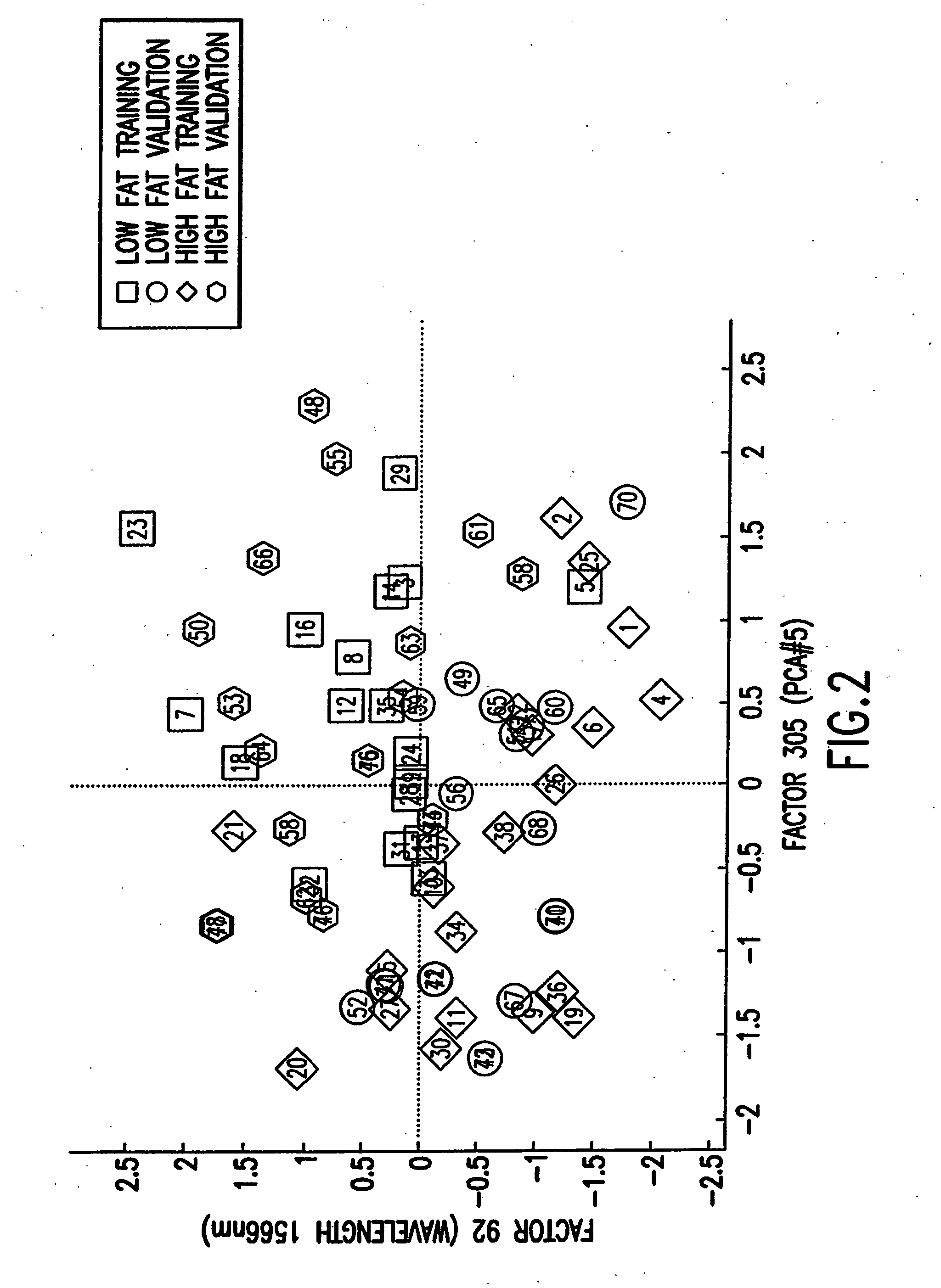Binary prediction tree modeling with many predictors and its uses in clinical and genomic applications
a prediction tree and predictor technology, applied in the field of classification tree models, can solve problems such as multiple predictors, and achieve the effect of accurately predicting outcomes for individual patients
- Summary
- Abstract
- Description
- Claims
- Application Information
AI Technical Summary
Problems solved by technology
Method used
Image
Examples
example 1
Analysis of Biscuit Dough Data
[0187] A first example concerns the application of biscuit dough data (publicly available at Osborne, B. G., Fearn, T., Miller, A. R. and Douglas, S., Applications of near infrared reflectance spectroscopy to compositional analysis of biscuits and biscuit doughs, J. Sci. Food Agric., 35, 99-105 (1984); Brown, P. J., Fearn, T. and Vannucci, M., The choice of variables in multivariate regression: A non-conjugate Bayesian decision theory approach, Biometrika, 86, 635-648 (1999)) in which interest lies in relating aspects of near infrared (“NIR”) spectra of dough to the fat content of the resulting biscuits. The data set provides 78 samples, of which 39 are taken as training data and the remaining 39 as validation cases to be predicted, precisely as in Brown et al (1999). The binary outcome is 0 / 1 according to whether the measured fat content exceeds a threshold, where the threshold is the mean of the sample of fat values. As predictors, each xi comprises ...
example 2
Metagene Expression Profiling to Predict Estrogen Receptor Status of Breast Cancer Tumors
[0192] This example illustrates not only predictive utility but also exploratory use of the tree analysis framework in exploring data structure. Here, the tree analysis is used to predict estrogen receptor (“ER”) status of breast tumors using gene expression data. Prior analyses of such data involved binary regression models which utilized Bayesian generalized shrinkage approaches to factor regression. Specifically, prior statistical models involved the use of probit linear regression linking principal components of selected subsets of genes to the binary (ER positive / negative) outcomes. See West, M., Blanchette, C., Dressman, H., Ishida, S., Spang, R., Zuzan, H., Marks, J. R. and Nevins, J. R. Utilization of gene expression profiles to predict the clinical status of human breast cancer. Proc. Natl. Acad. Sci., 98, 11462-11467 (2001). However, the tree model taught in the instant invention pres...
example 3a
Prediction of Lymph Node Metastases and Cancer Recurrence
[0206] This study assesses complex, multivariate patterns in gene expression data from primary breast tumor samples that can accurately predict nodal metastatic states and relapse for the individual patient using the statistical tree model of the invention. DNA microarray data on samples of primary breast tumors was generated to which non-linear statistical analyses embodied by the tree model of the invention was applied to evaluate multiple patterns of interactions of groups of genes that have true predictive value, at the individual patient level, with respect to lymph node metastasis and cancer recurrence. For both lymph node metastasis and cancer recurrence, patterns of gene expression (metagenes) were identified that associate with outcome.
[0207] Much more importantly, these patterns were capable of honestly predicting outcomes in individual patients with about 90% accuracy, based on a simple threshold of 0.5 probabilit...
PUM
| Property | Measurement | Unit |
|---|---|---|
| wavelength | aaaaa | aaaaa |
| size | aaaaa | aaaaa |
| size | aaaaa | aaaaa |
Abstract
Description
Claims
Application Information
 Login to View More
Login to View More - R&D
- Intellectual Property
- Life Sciences
- Materials
- Tech Scout
- Unparalleled Data Quality
- Higher Quality Content
- 60% Fewer Hallucinations
Browse by: Latest US Patents, China's latest patents, Technical Efficacy Thesaurus, Application Domain, Technology Topic, Popular Technical Reports.
© 2025 PatSnap. All rights reserved.Legal|Privacy policy|Modern Slavery Act Transparency Statement|Sitemap|About US| Contact US: help@patsnap.com



